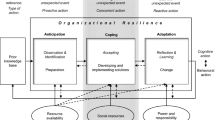Abstract
Following the Asian Tsunami of 2004 and during the Israel–Lebanon Crisis of 2006, Sweden sent small crisis response teams to support civilians. The small size of the teams, combined with situations that did not always play out according to expectations and plans, presented a challenge to their resilience—their ability to adapt to circumstances outside of plans made in advance. In this paper, we analyze the experiences of 14 members of Swedish field teams involved in the crises response, based on focus group discussions. We describe a cycle of preparing for role improvisation, of taking improvised roles, of working in them, and of getting out of them when they are no longer a benefit. The discussions revealed that although role improvisation was seen as necessary to get the work done, they also saw a need to manage negative side effects and vulnerabilities of role improvisation in various ways. We discuss training goals based on their experiences, to address perceived strengths and vulnerabilities of role improvisation. We also discuss factors affecting role improvisation, such as a resilience climate of shared attitudes. Our results can be useful for organizations that have or that plan to adopt flexible crisis response teams. Our results can also be of interests to a more general audience with an interest in how practices necessary for resilience can bring negative side effects, for instance, resilience loss in the organization after an initial adaptive stage.
Similar content being viewed by others
References
Alvinius A, Danielsson E, Larsson G (2010) Structure versus freedom of action: leadership during the rescue operation following the 2004 tsunami. Int J Emerg Manag 7(3):304–322
Brown C, Eriksson K (2008) A plan for (certain) failure: possibilities for and challenges of more realistic emergency plans. Int J Emerg Manag 5(3):292–310
Chelariu C, Johston WJ, Young L (2002) Learning to improvise, improvising to learn: a process of responding to complex environments. J Bus Res 55(2):141–147
Comfort L (1994) Self organization in complex systems. J Public Adm Res Theory 4(3):393–410
Comfort L (1996) Self organization in disaster response: the great Hanshin, Japan earthquake of January 17, 1995. Quick response report no. 78. Natural Hazards Centre, University of Colorado, Boulder, CO
Creswell J (2007) Qualitative inquiry and research design: choosing among five approaches, 2nd edn. Sage Publications, Thousand Oaks
Crossan MM (1998) Improvisation in action. Oper Res 9(5):593–599
Cunha M, Cunha J, Kamoche K (1999) Organizational improvisation: what, when, how and why. Int J Manag Rev 1(3):299–341
Drabek TE, McEntire DA (2003) Emergent phenomena and the sociology of disaster: lessons, trends and opportunities from the research literature. Disaster Prev Manag 12(2):97–112
Furniss D, Back J, Blandford A, Hildebrandt M, Broberg H (2011) A resilience markers framework for small teams. Reliab Eng Syst Saf 96(1):2–10
Guldenmund FW (2000) The nature of safety culture: a review of theory and research. Saf Sci 34(1):215–257
Heath R (1998) Dealing with the complete crisis—the crisis management shell structure. Saf Sci 30(1–2):139–150
Holling C (1973) Resilience and stability of ecological systems. Annu Rev Ecol Syst 4:1–23
Hollnagel E (2012) Fram: the functional resonance analysis method—modelling complex socio-technical systems. Ashgate, Farnham
Hollnagel E, Woods DD, Leveson N (2006) Resilience engineering: concepts and precepts. Ashgate, Aldershot
Ivansson G (2006) Lebanon. Sirenen. Swedish Rescue Services Agency
Katastrofkommisionen (2005) Sverige och tsunamin—granskning och förslag. Regeringskansliet, Stockholm
Klein KJ, Ziegert JC, Knight AP, Xiao Y (2006) Dynamic delegation: shared, hierarchical, and deindividualized leadership in extreme action teams. Adm Sci Q 51(4):590–621
Kulling P, Sigurdsson S, Hamberger B (2008) Kamedo report no. 92 evacuation of swedes from lebanon—observational studies in connection with the war in lebanon in summer 2006. Prehosp Disaster Med 23(5):476–480
Lundberg J, Asplund M (2011) Communication problems in crisis response. In: Proceedings of the 8th international ISCRAM conference
Lundberg J, Johansson B (2006) Resilience, stability and requisite interpretation in accident investigations. In: Proceedings of 2nd resilience engineering symposium, Juan-les-Pins, France, 8–10 Nov
Lundberg J, Törnqvist E, Nadjm-Tehrani S (2012) Resilience in sensemaking and control of emergency response. Int J Emerg Manag 8(2):99–122
Manyena SB (2006) The concept of resilience revisited. Disasters 30(4):434–450
Mendonca D, Fiedrich F (2006) Training for improvisation in emergency management: opportunities and limits for information technology. Int J Emerg Manag 3(4):348–363
Mendonca D, Wallace WA (2006) Adaptive capacity: electric power restoration in New York City following the 11 September 2001 attacks. In: Proceedings of 2nd resilience engineering symposium Juan-les-Pins, France, 8–10 Nov
Mendonca D, Beroggi GEG, Wallace WA (2001) Decision support for improvisation during emergency response operations. Int J Emerg Manag 1(1):30–38
Miles MB, Huberman AM (1994) Qualitative data analysis: an expanded sourcebook. Sage, Thousand Oaks
Ministry of Foreign Affairs (2006) The foreign service’s handling of the lebanon crisis report, views, measures and proposals. Ministry of Foreign Affairs, Stockholm
Moorman C, Miner AS (1998) Organizational improvisation and organizational memory. Acad Manag Rev 23(4):698–723
Rankin A, Lundberg J, Woltjer R (2011a) Resilience strategies for managing everyday risks. In: Proceedings of the 4th resilience engineering symposium, Sophia Antipolis, France
Rankin A, Dahlbäck N, Lundberg J (2011b) A case study of factor influencing role improvisation in crisis response teams. Cogn Technol Work. doi:10.1007/s10111-011-0186-3
Rittel HWJ, Webber MM (1973) Dilemmas in a general theory of planning. Policy Sci 4(2):155–169
Strauss A, Corbin J (1998) Basics of qualitative research: grounded theory, procedures and techniques. Sage, Newbury Park
Trnka J, Rankin A, Jungert E, Lundberg J, Granlund R, Granlund H, Johansson B (2009) Information support in modern crisis and disaster response operations. Linköping University, Linköping
Wachtendorf T (2004) Improvising 9/11: organizational improvisation following the world trade center disaster. PhD, University of Delaware, Delaware
Webb G (2004) Role improvising during crisis situations. Int J Emerg Manag 2(1):47–61
Webb G, Chevreau F (2006) Planning to improvise: the importance of creativity and flexibility in crisis response. Int J Emerg Manag 3(1):66–72
Webb GR, Mcmichae M, Noon J, Patterson T (1999) Role improvising under conditions of uncertainty: a classification of types. University of Delaware, Delaware
Weick K (1993) The collapse of sensemaking in organizations: the Mann Gulch disaster. Adm Sci Q 38(4):628–652
Weick KE (1998) Introductory essay: improvisation as a mindset for organizational analysis. Organ Sci 9(5):543–555
Woods D (2006) Essential characteristics of resilience. In: Hollnagel E, Woods D, Leveson N (eds) Resilience engineering: concepts and precepts. Ashgate, Aldershot, pp 21–34
Wreathall J (2009) Measuring resilience. In: Nemeth C, Hollnagel E, Dekker S (eds) Resilience engineering perspectives, vol 2, preparation and restoration. Ashgate, Farnham, pp 95–114
Acknowledgments
We would like to thank our informants who shared their experiences during the focus groups. The Swedish Civil Contingencies Agency sponsored this research.
Author information
Authors and Affiliations
Corresponding author
Rights and permissions
About this article
Cite this article
Lundberg, J., Rankin, A. Resilience and vulnerability of small flexible crisis response teams: implications for training and preparation. Cogn Tech Work 16, 143–155 (2014). https://doi.org/10.1007/s10111-013-0253-z
Received:
Accepted:
Published:
Issue Date:
DOI: https://doi.org/10.1007/s10111-013-0253-z




